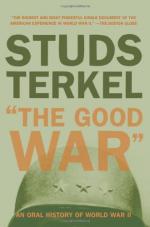
|
| Name: _________________________ | Period: ___________________ |
This test consists of 15 multiple choice questions and 5 short answer questions.
Multiple Choice Questions
1. Where was Robert Rasmus when the bomb was dropped on Hiroshima?
(a) Fighting in the South Pacific.
(b) Training for the invasion of Japan.
(c) Fighting in Germany.
(d) Fighting in France.
2. Why were American soldiers anxious to get points for earning medals?
(a) Soldiers wanted to impress their officers.
(b) Soldiers wanted to impress their girlfriends.
(c) Soldiers wanted to look good to their buddies.
(d) Soldiers were shipped home in order of accumulated points.
3. What worried Peggy Terry when the tetryl she was working with turned her hair orange?
(a) Other women would think she had dyed her hair.
(b) The toxic ingredients might make her sick.
(c) The toxic fumes might kill her.
(d) The toxic ingredients might make her sterile.
4. Why did Robert Rasmus believe the Americans should be grateful to the Russians?
(a) The Russians diverted the German army.
(b) The Russians were their comrades and allies.
(c) The Russians did the lion's share of the fighting.
(d) The Russians opened the door for the American invasion.
5. What surprised Anton Biler about his Japanese overseer in the prison camp?
(a) He was against the war.
(b) He spoke English.
(c) He was from Seattle.
(d) He was kind.
6. What did Admiral Larocque think of the Japanese during the war?
(a) The Japanese were a superior race.
(b) The Japanese were a lesser species.
(c) The Japanese were unbeatable.
(d) The Japanese were wily and clever.
7. Why did Mike Royko spent nights in a pitch-black apartment as a child during the war?
(a) His parents were too poor to pay for electricity.
(b) The air raid wardens called for blackouts.
(c) Chicago was under attack.
(d) The government cut off electricity.
8. What unusual food did Ken Hourigan eat in the Philippines?
(a) Horse.
(b) Mouse.
(c) Cat.
(d) Dog.
9. What did the British women do with their goods during the war?
(a) Sold them.
(b) Hid them.
(c) Hoarded them.
(d) Swapped them.
10. Why was John Garcia brought before a navy court?
(a) He refused to go into a burning ship.
(b) He was accused of aiding the enemy.
(c) He was firing unauthorized ammunition.
(d) He lied about his age to enlist.
11. Under the Geneva Convention, what type of work did prisoners of war not have to do?
(a) Spying.
(b) Road repair.
(c) Manufacture of war material.
(d) Farming.
12. What did people in Paducah burn in a bonfire?
(a) All their German products.
(b) All their Japanese products.
(c) Posters of Hitler.
(d) Emperor Hirohito's effigy.
13. Why was Peggy Terry happy during the war?
(a) Shewanted to help defeat Hitler.
(b) She loved her job.
(c) For the first time, she had enough money.
(d) She enjoyed the sense of camaraderie.
14. Where does Richard Prendergast say the lower-ranked person walked with an officer?
(a) In front.
(b) On the left.
(c) Behind.
(d) On the right.
15. Why were thirty-two American servicemen killed after hearing the announcement of Japan's surrender?
(a) Executions for war crimes.
(b) Stray bullets from the celebration.
(c) Retaliation from the Hawaiian Japanese.
(d) Collisions caused by drunk driving.
Short Answer Questions
1. What causes the disease of beriberi, that stops kidney function?
2. How does Mike Royko believe most U.S. soldiers felt about the Korean conflict?
3. What did Paul Pisicano believe Italian Americans felt about the Axis countries in World War II?
4. Why did the soldiers in the Philippines write home, "Cancel the bonds."
5. Why did MacArthur land twice when returning to the Philippines?
|
This section contains 646 words (approx. 3 pages at 300 words per page) |

|




